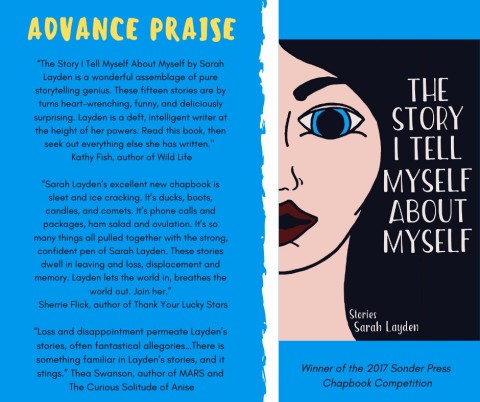
by Frannie McMillan
The 15 stories in Sarah Layden’s new collection of flash fiction, The Story I Tell Myself About Myself (Sonder Press, August 2018), offer readers failed couplings, bad medical news (or anticipated bad news), infertility, death, unexplained physical anomalies, attempted recovery, and a mad libs style fill-in-the-blank story. The Story I Tell Myself About Myself is the 2017 winner of the Sonder Press chapbook competition. A recipient of the Allen and Nirelle Galson Prize for fiction and an Association of Writers & Writing Programs Intro Award, Layden is the author of the novel Trip Through Your Wires, and her short fiction and non-fiction appear in a range of publications.
Described by NUVO writers Dan Grossman and Laura MacPhee as “Slippery, secretive, and sensual, Layden’s short fiction is simply magical,” The Story I Tell Myself About Myself brims with secrets and words left unsaid. There is a Bradbury-esque feeling to these quirky, sometimes otherworldly stories. Reading them is like that moment of realization, hours later, that you said something insensitive, or forgot something that you needed to say.
The first piece, “Hang Up,” introduces readers to a man who has been calling the same woman for fifteen years. He never speaks when he calls, and she tells him stories over the phone. “Hang Up” is such a fitting introduction to this collection because, like the female character in this story, Layden’s voice beckons the reader onward through an array of stories that range from the mundane to the fantastic. The last few lines plead, “You are the story I tell myself, about myself. Stay with me. Stay.”
“Decoy,” a tense, tightly woven story about a woman named Alice, manages to be lightly humorous and gut-wrenching at the same time. I’m left not knowing what happens to Alice’s daughter, Sylvie, by the end. From the ducks on the pond to the “mostly harmless lies” that Alice remembers using as a kid, “camouflaging her whereabouts,” Layden explores the many meanings of the word “decoy.” Even the color of ice on the pond is “a trick of the orange and purple sunset.” Sylvie hopes to “attract the real thing” with her ducks on the windowsill; Alice wonders why people ruin brand-new furniture by making it look shabby, hiding its newness under a beaten façade while also thinking, “the face ought to map your life,” explaining why she declined the Botox proffered by her dentist-turned-date.
“He Waits, Wants” was so perfect that I, having experienced infertility, could hardly stand it. In a delightful twist, Layden creates a world where the male is physically responsible for carrying a child. He charts his cycles, takes his temperature, and pees on the ovulation stick, while his female spouse just wants to go to the bar after they finish having sex. She is annoyed with his constant worrying, but admits to feeling jealousy when the neighbor’s kid “got knocked up at sixteen.” While there is a humorous element to this piece, Layden skillfully illustrates a role reversal that gives both sides a chance to wear the other’s shoes.
“The Woman Who Was a House” features a woman whose body was an actual house, vacant after her family moved to the Caribbean to pursue a life as underwater Civil War reenactors. “The Woman with No Skin” deals with a character whose protective suit became covered in the words of others. Both pieces explore some of the ways women adapt to being taken advantage of or hurt by the world. In “Arrested Development” readers meet Vera, a woman who never grew and still looks like a child. Like the female character in “New Thing,” Vera is “waiting for the knock at the door that would change her life, but it was usually the mailman with a package she had specifically ordered.” Layden portrays women who are making the best of their circumstances, surviving life at a day-to-day pace. While women take center stage in this collection, “Comet’s Return,” “Marv’s 11 Steps,” and “Two Hearts,” showcase Layden’s ability to write a believable and compelling male perspective.
Male or female, Layden’s characters are faithful to their routines. The characters in each story are connected to various daily rituals or lifestyles. Some seem to question these practices, and some seem oblivious to them. For example, the man in “Hang Up” always calls the woman, and she always tells him a story. The woman in “The Rest of Your Life” always takes a moment to wink at her reflection in the elevator. “Sex in Secret” considers the old habits of sexual encounters before the digital age created new ones. The couple in “He Waits, Wants” is tied to the schedule dictated by infertility. Davey considers his own habits in the context of his father’s lifelong pattern of alcoholism and womanizing in “Comet’s Return.” “The Woman Who Was a House” replays old family films through the projector in her lungs. Vera is tied to her routine of watching television and eating junk food while she waits for her life to change in “Arrested Development.” Marv, the title character in “Marv’s 11 Steps,” is so loyal to his daily routine of visiting the newsstand that the narrator observes “daily he paced this sidewalk, a short Marv-sized path worn into the cement.” Marv visits the same bar, makes the same joke as the same song plays on the jukebox every night, his feet “stepping in the same cracked pattern” on the dance floor. “Collision Physics for the Math-Averse” considers how these patterns and routines can shift and alter lives. The Story I Tell Myself About Myself gives you no choice but this: stay. Stay with these characters and listen to what they have to tell you.
The Story I Tell Myself About Myself is available from Sonder Press and elsewhere online.
_____________________________
 Frannie McMillan’s poetry has appeared in The Coachella Review, K’in Literary Journal, The Indianapolis Review, and others. She is currently at work on her first chapbook, You Ain’t By Yourself. By day, she connects young people with books as a secondary librarian in Richmond, Virginia. You can find her on Twitter @franniemaq.
Frannie McMillan’s poetry has appeared in The Coachella Review, K’in Literary Journal, The Indianapolis Review, and others. She is currently at work on her first chapbook, You Ain’t By Yourself. By day, she connects young people with books as a secondary librarian in Richmond, Virginia. You can find her on Twitter @franniemaq.

 The core workshop of SmokeLong Fitness is all in writing, so you can take part from anywhere at anytime. We are excited about creating a supportive, consistent and structured environment for flash writers to work on their craft in a community. We are thrilled and proud to say that our workshop participants have won, placed, or been listed in every major flash competition. Community works.
The core workshop of SmokeLong Fitness is all in writing, so you can take part from anywhere at anytime. We are excited about creating a supportive, consistent and structured environment for flash writers to work on their craft in a community. We are thrilled and proud to say that our workshop participants have won, placed, or been listed in every major flash competition. Community works.